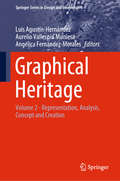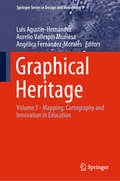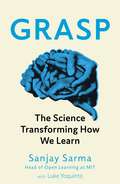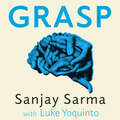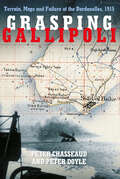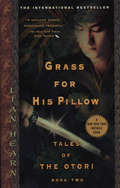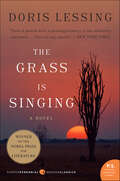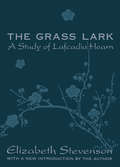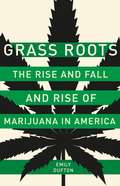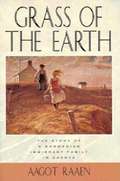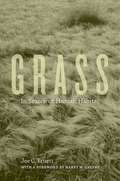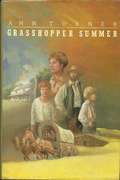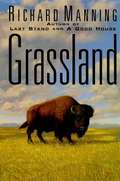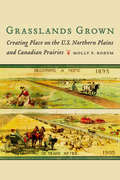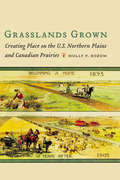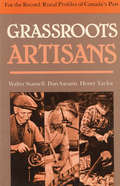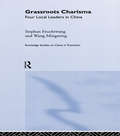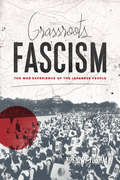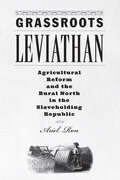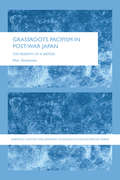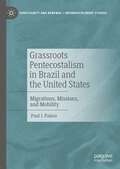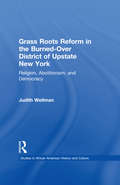- Table View
- List View
Graphical Heritage: Volume 2 - Representation, Analysis, Concept and Creation (Springer Series in Design and Innovation #6)
by Luis Agustín-Hernández Aurelio Vallespín Muniesa Angélica Fernández-MoralesThis book presents the proceedings of the 18th International Conference on Graphic Design in Architecture, EGA 2020, focusing on heritage – including architectural and graphic heritage as well as the graphics of heritage. Consisting of two parts: “Representation and Analysis” and “Concept and Creation”, this second volume gathers selected contributions on topics ranging from graphic representation to the graphic presentation of ideas, i.e. artistic creation, to bridge the gap between graphic heritage and the graphics of heritage. Given its scope, this volume will appeal to architectural and graphic designers, artists and engineers, providing them with extensive information on new methods and a source of inspiration for future research and interdisciplinary collaborations.
Graphical Heritage: Volume 3 - Mapping, Cartography and Innovation in Education (Springer Series in Design and Innovation #7)
by Luis Agustín-Hernández Aurelio Vallespín Muniesa Angélica Fernández-MoralesThis book presents the proceedings of the 18th International Conference on Graphic Design in Architecture, EGA 2020, focusing on heritage – including architectural and graphic heritage as well as the graphics of heritage. The third of three volumes, this book discusses topics related to mapping, cartography and landscape, as well as innovative education methods, particularly in the context of teaching architectural heritage. It covers historical cartography and new cartographies, as well as methods for representing the landscape, and reports on different learning methods and practices, including classroom methods but also those involving more active participation and multidisciplinary and collaborative production. Given its scope, this book will appeal cartographers, designers and teachers, providing them with extensive information on innovative methodologies and a source of inspiration for their future work.
Grasp: The Science Transforming How We Learn
by Sanjay Sarma Luke Yoquinto'Sarma's book may be the most important work on education written this century' - SkepticAs the head of Open Learning at MIT, Sanjay Sarma has a daunting job description: to fling open the doors of the MIT experience for the benefit of the wider world. But if you're going to undertake such an ambitious project, you must first ask: How exactly does learning work? What conditions are most conducive? Are our traditional classroom methods - lecture, homework, test, repeat - actually effective? And if not, which techniques are?Grasp takes readers across multiple frontiers, from fundamental neuroscience to cognitive psychology and beyond, as it explores the future of learning. For instance:· Scientists are studying the role of forgetting, exposing it not as a simple failure of memory but a critical weapon in our learning arsenal· New developments in neuroimaging are helping us understand how reading works in the brain. It's become possible to identify children who might benefit from specialised dyslexia interventions - before they learn to read· Many schools have begun converting to flipped classrooms, in which you watch a lesson at home, then do your 'homework' in classAlong the way, Sarma debunks long-held views such as the noxious idea of 'learning styles,' while equipping readers with a set of practical tools for absorbing and retaining information across a lifetime of learning. He presents a vision for learning that's more inclusive and democratic - revealing a world bursting with powerful learners, just waiting for the chance they deserve.Drawing from the author's experience as an educator and the work of researchers and educational innovators at MIT and beyond, Grasp offers scientific and practical insight, promising not just to inform and entertain readers but to open their minds.
Grasp: The Science Transforming How We Learn
by Sanjay Sarma Luke Yoquinto'Sarma's book may be the most important work on education written this century' - SkepticAs the head of Open Learning at MIT, Sanjay Sarma has a daunting job description: to fling open the doors of the MIT experience for the benefit of the wider world. But if you're going to undertake such an ambitious project, you must first ask: How exactly does learning work? What conditions are most conducive? Are our traditional classroom methods - lecture, homework, test, repeat - actually effective? And if not, which techniques are?Grasp takes readers across multiple frontiers, from fundamental neuroscience to cognitive psychology and beyond, as it explores the future of learning. For instance:· Scientists are studying the role of forgetting, exposing it not as a simple failure of memory but a critical weapon in our learning arsenal· New developments in neuroimaging are helping us understand how reading works in the brain. It's become possible to identify children who might benefit from specialised dyslexia interventions - before they learn to read· Many schools have begun converting to flipped classrooms, in which you watch a lesson at home, then do your 'homework' in classAlong the way, Sarma debunks long-held views such as the noxious idea of 'learning styles,' while equipping readers with a set of practical tools for absorbing and retaining information across a lifetime of learning. He presents a vision for learning that's more inclusive and democratic - revealing a world bursting with powerful learners, just waiting for the chance they deserve.Drawing from the author's experience as an educator and the work of researchers and educational innovators at MIT and beyond, Grasp offers scientific and practical insight, promising not just to inform and entertain readers but to open their minds.
Grasping Gallipoli: Terrain, Maps and Failure at the Dardanelles, 1915
by Peter Doyle Peter ChasseaudThe failure of the Gallipoli campaign was instantly blamed on a great untruth – that the War Office was unprepared. This book, incorporating information unavailable elsewhere, shows that in fact the WO and the Admiralty had amassed a huge amount of data. Aerial reconnaissance had played a part – even Lawrence of Arabia had done his bit! The War Office knew all about Greek plans to capture the peninsula and one plan was even Anglo-Greek. The authors examine all the intelligence and how it was used or ignored and in the process, in the words of the late Richard Holmes they ‘illuminate a wildly beautiful landscape, which never fails to charm and shock me in equal measure.’
Grass For His Pillow: Episode 2 The Way Through The Snow (Tales of the Otori #2)
by Lian HearnBoth Takeo and Kaede have visions of their future. Takeo works to escape the Tribe and fulfill the last wishes of his adoptive father, Lord Shigeru Otori. And Kaede, heir to two seats of power, moves forward step by step, aided by her own wits and a precarious alliance with Lord Fujiwara. In their separate worlds, the two long for each other, knowing that they are meant to be together, wondering if they will ever see each other again. . . .
Grass For His Pillow: Tales of Otori, Book Two
by Lian HearnBoth Takeo and Kaede have visions of their future. Takeo works to escape the Tribe and fulfill the last wishes of his adoptive father, Lord Shigeru Otori. And Kaede, heir to two seats of power, moves forward step by step, aided by her own wits and a precarious alliance with Lord Fujiwara. In their separate worlds, the two long for each other, knowing that they are meant to be together, wondering if they will ever see each other again. . . .
Grass Is Singing: A Novel (Penguin Readers Ser.penguin Readers Series #Level 5)
by Doris Lessing"There is passion here, a piercing accuracy, a rare sensitivity and power. . . . One can only marvel." — New York TimesSet in Southern Rhodesia under white rule, Doris Lessing's first novel is at once a riveting chronicle of human disintegration, a beautifully understated social critique, and a brilliant depiction of the quiet horror of one woman's struggle against a ruthless fate.Mary Turner is a self-confident, independent young woman who becomes the depressed, frustrated wife of an ineffectual, unsuccessful farmer. Little by little the ennui of years on the farm works its slow poison. Mary's despair progresses until the fateful arrival of Moses, an enigmatic black servant. Locked in anguish, Mary and Moses—master and slave—are trapped in a web of mounting attraction and repulsion, until their psychic tension explodes with devastating consequences.
Grass Lark: Study of Lafcadio Hearn
by Elizabeth StevensonIt is remarkable how persistent a "minor" writer may be. He may lack the large vision and universal message of the great writer, but instead possess a clear, true, intense view of particular places, peoples, and situations that renders hi work unique and irreplacable. Lafcadio Hearn (1850-1904) is such a figure in American literature. Best known as a scholar of Japanese culture, Hearn was a remarkable journalist, translator, travel writer, and perhaps second only to Poe in the literature of the macabre and supernatural. Hearn's life, as strange and colorful as his work, is brilliantly recounted in Elizabeth Stevenson's sensitive and sympathetic biography., The range of Hearn's writing is reflected in the peripatetic course of his life. The son of an Irish father and a Greek mother, he was born on the Ionian island of Leucadia, was raised in Dublin, and came to America at the age of nineteen. His early career was spent as a journalist. Without a trace of condescension or pity he entered into the lives of the dock workers of Cincinnati, the Creoles of New Orleans and Martinique, and later the common villagers of Japan, describing how they lived and worked and what they believed., Elizabeth Stevenson's book is as much about the writer as the man. While giving an accurate measure of the scale of Hearn's achievement, she makes a compelling case for its artistry. Her readlng demonstrates that his writings are not mere aids to the understanding of various cultures but ends in themselves. Hearn did not just translate the folklore of other cultures, he recreated it. The Grass Lark will interest literary scholars. American studies specialists, and folklorists.
Grass Roots: The Rise and Fall and Rise of Marijuana in America
by Emily DuftonHow earnest hippies, frightened parents, suffering patients, and other ordinary Americans went to war over marijuanaIn the last five years, eight states have legalized recreational marijuana. To many, continued progress seems certain. But pot was on a similar trajectory forty years ago, only to encounter a fierce backlash. In Grass Roots, historian Emily Dufton tells the remarkable story of marijuana's crooked path from acceptance to demonization and back again, and of the thousands of grassroots activists who made changing marijuana laws their life's work.During the 1970s, pro-pot campaigners with roots in the counterculture secured the drug's decriminalization in a dozen states. Soon, though, concerned parents began to mobilize; finding a champion in Nancy Reagan, they transformed pot into a national scourge and helped to pave the way for an aggressive war on drugs. Chastened marijuana advocates retooled their message, promoting pot as a medical necessity and eventually declaring legalization a matter of racial justice. For the moment, these activists are succeeding--but marijuana's history suggests how swiftly another counterrevolution could unfold.
Grass of the Earth: Immigrant Life in the Dakota Country
by Aagot RaaenThis is an engaging, richly detailed biography of a family of Norwegian immigrant homesteaders in eastern North Dakota in the late 1800s.
Grass: In Search of Human Habitat
by Joe C. TruettThe book explores the deep affinities between humans and our original habitat: grasslands. It traces the evolutionary, historical, and cultural forces that have reshaped North American rangelands over the past two centuries.
Grasshopper Summer
by Ann Warren TurnerIn 1874, 11-year-old Sam and his family move from Kentucky to the Dakota territory. They anticipate hardships, but no one expects a plague of locusts so devastating an entire year's worth of crops is lost.
Grassland: The History, Biology, Politics, and Promise of the American Prairie
by Richard ManningThe author, an award-winning journalist and nature writer, looks at the grasslands of the American West and Midwest, tracing the region from pre-history to the present. He discusses attempts to control the land and efforts to restore native grasses and wild herds of buffalo, and visits Ted Turner's progressive and controversial Montana ranch. Annotation c. by Book News, Inc., Portland, Or.
Grasslands Grown: Creating Place on the U.S. Northern Plains and Canadian Prairies
by Molly P. RozumIn Grasslands Grown Molly P. Rozum explores the two related concepts of regional identity and sense of place by examining a single North American ecological region: the U.S. Great Plains and the Canadian Prairie Provinces. All or parts of modern-day Alberta, Montana, Saskatchewan, North Dakota, South Dakota, and Manitoba form the center of this transnational region. As children, the first postconquest generation of northern grasslands residents worked, played, and traveled with domestic and wild animals, which introduced them to ecology and shaped sense-of-place rhythms. As adults, members of this generation of settler society worked to adapt to the northern grasslands by practicing both agricultural diversification and environmental conservation. Rozum argues that environmental awareness, including its ecological and cultural aspects, is key to forming a sense of place and a regional identity. The two concepts overlap and reinforce each other: place is more local, ecological, and emotional-sensual, and region is more ideational, national, and geographic in tone. This captivating study examines the growth of place and regional identities as they took shape within generations and over the life cycle.
Grasslands Grown: Creating Place on the U.S. Northern Plains and Canadian Prairies
by Molly P. RozumIn Grasslands Grown Molly P. Rozum explores the two related concepts of regional identity and sense of place by examining a single North American ecological region: the U.S. Great Plains and the Canadian Prairie Provinces. All or parts of modern-day Alberta, Montana, Saskatchewan, North Dakota, South Dakota, and Manitoba form the center of this transnational region. As children, the first postconquest generation of northern grasslands residents worked, played, and traveled with domestic and wild animals, which introduced them to ecology and shaped sense-of-place rhythms. As adults, members of this generation of settler society worked to adapt to the northern grasslands by practicing both agricultural diversification and environmental conservation. Rozum argues that environmental awareness, including its ecological and cultural aspects, is key to forming a sense of place and a regional identity. The two concepts overlap and reinforce each other: place is more local, ecological, and emotional-sensual, and region is more ideational, national, and geographic in tone. This captivating study examines the growth of place and regional identities as they took shape within generations and over the life cycle.
Grassroots Artisans: Walter Stansell, Dan Sarazin, Henry Taylor
by Barry Lloyd PenhaleWalter Stansell of Straffordville, Dan Sarazin of Golden Lake, and Henry Taylor of Bancroft did what they had to do to preserve some of Canada's rural history. Stansell preserved the age of steam by building working models of machines used during the past century. Master canoe make Dan Sarazin (Chief White Eagle) has given many hours of his time to the preservation of old Native skills. Taylor still builds hand hewn log cabins, splits his own shingles with pioneer tools and carves reminders of early days in the bush. These three extraordinary men have done more than salvage some of Canada's past. Each in his own way actually made history at the Grass Roots level. Through extensive research involving oral history and the uncovering of a wide range of materials, i.e. vintage photographs, diaries, maps and sketchbooks, Barry Lloyd Penhale, journalist and broadcaster, has assembled an outstanding archival collection of Canadiana. In recalling colourful and courageous characters and communities of bygone eras, the publishers hope to partly fill the vacuum so long apparent in the preservation of our distinctive heritage.
Grassroots Charisma: Four Local Leaders in China (Routledge Studies on China in Transition #Vol. 10)
by Stephan Feuchtwang Wang MingmingThis book relates the stories of four leaders under very different political regimes: Colonial, Nationalist and Communist. The authors compare Chinese notions of respect and inspiration with their equivalents in other religious and political histories of colonial and post-colonial modernity, thereby producing a thorough re-working of the idea of charisma. The result is an intriguing study of the relationship between religious and political authority in a changing world.
Grassroots Fascism: The War Experience of the Japanese People
by Ethan Mark Yoshimi YoshiakiGrassroots Fascism profiles the Asia Pacific War (1941--1945) -- the most important though least understood experience of Japan's modern history -- through the lens of ordinary Japanese life. Moving deftly from the struggles of the home front to the occupied territories to the ravages of the front line, the book offers rare insight into popular experience from the war's troubled beginnings through Japan's disastrous defeat in 1945 and the new beginning it heralded.Yoshimi Yoshiaki mobilizes personal diaries, memoirs, and government documents to portray the ambivalent position of ordinary Japanese as both wartime victims and active participants. He also provides equally penetrating accounts of the war experience of Japan's imperial subjects, including Koreans and Taiwanese. This book challenges the idea that the Japanese operated as a passive, homogenous mass during the war -- a mere conduit for a military--imperial ideology imposed upon them by the political elite. Viewed from the bottom up, wartime Japan unfolds as a complex modern mass society, with a corresponding variety of popular roles and agendas. In chronicling the diversity of the Japanese social experience, Yoshimi's account elevates our understanding of Japan's war and "Japanese Fascism," and in its relation of World War II to the evolution -- and destruction -- of empire, it makes a fresh contribution to the global history of the war. Ethan Mark's translation supplements the Japanese original with explanatory annotations and an in-depth analytical introduction, drawing on personal interviews to situate the work within Japanese studies and global history.
Grassroots Fascism: The War Experience of the Japanese People (Weatherhead Books on Asia)
by Yoshiaki YoshimiGrassroots Fascism profiles the Asia Pacific War (1937–1945)—the most important though least understood experience of Japan's modern history—through the lens of ordinary Japanese life. Moving deftly from the struggles of the home front to the occupied territories to the ravages of the front line, the book offers rare insights into popular experiences from the war's troubled beginnings through Japan's disastrous defeat in 1945 and the new beginning it heralded.Yoshimi Yoshiaki mobilizes diaries, letters, memoirs, and government documents to portray the ambivalent position of ordinary Japanese as both wartime victims and active participants. He also provides penetrating accounts of the war experiences of Japan's minorities and imperial subjects, including Koreans and Taiwanese. His book challenges the idea that the Japanese people operated as a mere conduit for the military during the war, passively accepting an imperial ideology imposed upon them by the political elite. Viewed from the bottom up, wartime Japan unfolds as a complex modern mass society, with a corresponding variety of popular roles and agendas.In chronicling the diversity of wartime Japanese social experience, Yoshimi's account elevates our understanding of "Japanese Fascism." In its relation of World War II to the evolution—and destruction—of empire, it makes a fresh contribution to the global history of the war. Ethan Mark's translation supplements the Japanese original with explanatory notes and an in-depth introduction that situates the work within Japanese studies and global history.
Grassroots Garveyism
by Mary G. RolinsonThe black separatist movement led by Marcus Garvey has long been viewed as a phenomenon of African American organization in the urban North. But as Mary Rolinson demonstrates, the largest number of Universal Negro Improvement Association (UNIA) divisions and Garvey's most devoted and loyal followers were found in the southern Black Belt. Tracing the path of organizers from northern cities to Virginia, and then from the Upper to the Deep South, Rolinson remaps the movement to include this vital but overlooked region.Rolinson shows how Garvey's southern constituency sprang from cities, countryside churches, and sharecropper cabins. Southern Garveyites adopted pertinent elements of the movement's ideology and developed strategies for community self-defense and self-determination. These southern African Americans maintained a spiritual attachment to their African identities and developed a fiercely racial nationalism, building on the rhetoric and experiences of black organizers from the nineteenth-century South. Garveyism provided a common bond during the upheaval of the Great Migration, Rolinson contends, and even after the UNIA had all but disappeared in the South in the 1930s, the movement's tenets of race organization, unity, and pride continued to flourish in other forms of black protest for generations.
Grassroots Leviathan: Agricultural Reform and the Rural North in the Slaveholding Republic (Studies in Early American Economy and Society from the Library Company of Philadelphia)
by Ariel RonHow the vast agricultural reform movement undertaken by northern farmers before the Civil War fundamentally recast the relationship of rural Americans to market forces and governing structures.Recipient of The Center for Civil War Research's 2021 Wiley-Silver Book Prize, Winner of the Theodore Saloutos Memorial Award by the Agricultural History SocietyThe United States was an overwhelmingly rural society before the Civil War and for some time afterward. There were cities and factories, of course, especially in the northern seaboard states. In 1860, Manhattan's population was nearing a million. Brooklyn, which had been farmland at the time of the American Revolution, was itself home to 250,000. New England's mill towns were already well known, and Chicago's growth elicited awe. But these were exceptions. In the same year, 80% of Americans lived in rural places of 2,500 inhabitants or fewer. While 59% of the labor force worked in agriculture, only 15% worked in manufacturing. As the newspaperman Jesse Buel put it at the time, agriculture remained "the great business of civilized life." In this sweeping look at rural society from the American Revolution to the Civil War, Ariel Ron argues that agricultural history is absolutely central to understanding the nation's formative period. Upending the myth that the Civil War pitted an industrial North against an agrarian South, Grassroots Leviathan traces the rise of a powerful agricultural reform movement spurred by northern farmers. Showing that farming dominated the lives of the majority of Americans, in the North and the South, through almost the entire nineteenth century, Ron traces how middle-class farmers in the "Greater Northeast" built a movement of semipublic agricultural societies, fairs, and periodicals that, together, fundamentally recast the relationship of rural people to market forces and governing structures. By the 1850s, Ron writes, this massive movement boasted over a thousand organizations and the influence to have Congress publish annual agricultural reports in editions that rivaled sales of Uncle Tom's Cabin, the era's runaway bestseller. As northern farmers became increasingly organized, they pressed new demands on the federal government that inevitably challenged the entrenched prerogatives of southern slaveholders. Ideologically and organizationally, agricultural reform conditioned the emergence of the Republican Party and the North's break with the slaveholding republic. The movement culminated in the creation of the US Department of Agriculture and the land-grant university system. These agencies reconfigured the nature and purpose of the American state at the same time as they came to revolutionize farming in the United States and the world over.Looking at farmers as serious independent agents in the making, unmaking, and remaking of the American republic, Grassroots Leviathan offers an original take on the causes of the Civil War, the rise of federal power, and American economic ascent during the nineteenth century.
Grassroots Pacifism in Post-War Japan: The Rebirth of a Nation (The University of Sheffield/Routledge Japanese Studies Series)
by Mari YamamotoGrassroots Pacifism in Post-War Japan presents new material on grassroots peace activism and pacifism in two major groups active in the post-World War 2 peace movement - workers and housewives. Yamamoto contends that the peace movement, which was organised in tandem with other activities to promote democratic, economic and humanitarian issues, served as a popular lever which helped to eliminate feudal remnants that lingered in Japanese society and individual attitudes after the war, thereby modernizing the political process and the outlook of the ordinary Japanese. Including extensive primary material such as letters, essays, memoirs and interviews, specialists in Japanese history, peace studies and women's studies will appreciate the richness of the text supporting Yamamoto's narrative of how workers' and women's political awareness developed under the influence of organizational and ideological interests and contemporary events.
Grassroots Pentecostalism in Brazil and the United States: Migrations, Missions, and Mobility (Christianity and Renewal - Interdisciplinary Studies)
by Paul J. PalmaThis book offers an historical and comparative profile of classical pentecostal movements in Brazil and the United States in view of their migratory beginnings and transnational expansion. Pentecostalism’s inception in the early twentieth century, particularly in its global South permutations, was defined by its grassroots character. In contrast to the top-down, hierarchical structure typical of Western forms of Christianity, the emergence of Latin American Pentecostalism embodied stability from the bottom up—among the common people. While the rise to prominence of the Assemblies of God in Brazil, the Western hemisphere’s largest (non-Catholic) denomination, demanded structure akin to mainline contexts, classical pentecostals such as the Christian Congregation movement cling to their grassroots identity. Comparing the migratory and missional flow of movements with similar European and US roots, this book considers the prospects for classical Brazilian pentecostals with an eye on the problems of church growth and polity, gender, politics, and ethnic identity.
Grassroots Reform in the Burned-over District of Upstate New York: Religion, Abolitionism, and Democracy (Studies in African American History and Culture)
by Judith WellmanFirst published in 2001. Routledge is an imprint of Taylor & Francis, an informa company.
